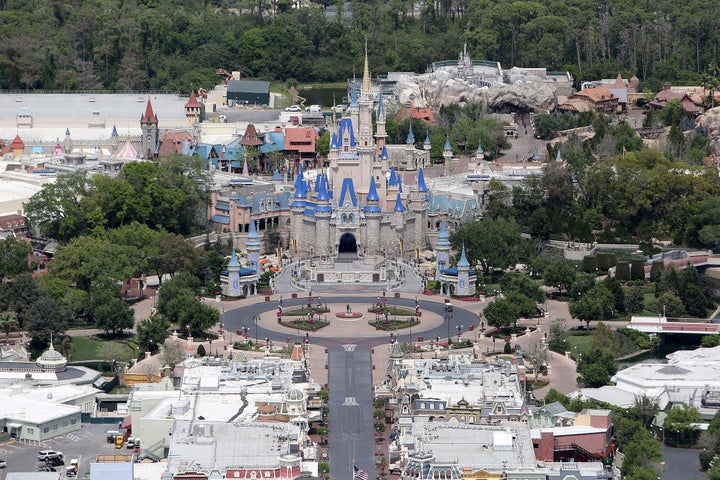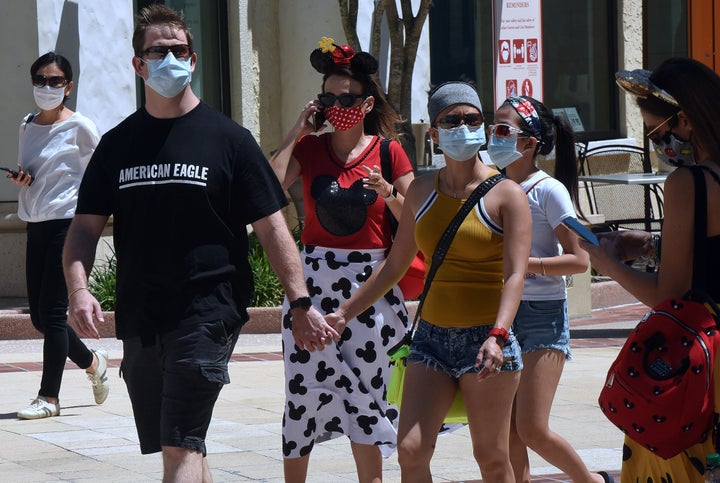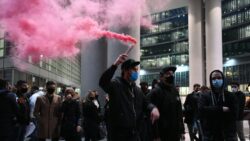Over the past few weeks, Disney has announced plans to reopen its U.S. theme parks in phases starting this summer. The reopening date for Walt Disney World in Florida is July 11, while California’s Disneyland is due to welcome guests on July 17.
These plans have prompted criticism, with thousands of people even signing a petition urging further delay to protect Disneyland’s workers and guests. But the company says it is taking measures to promote health and safety, including reduced capacity, temperature checks and mask requirements.
How effective these procedures will be in preventing the spread of the coronavirus has yet to be determined. But what we do know is that the theme park experience will be different in the age of COVID-19.
HuffPost asked hospitality experts and Disney park fanatics to share what they predict visiting Walt Disney World and Disneyland will be like this summer, based on the announced safety measures and their own informed speculation.
“I would guess some of these changes will take some getting used to, but I also suspect most guests will be understanding and have patience as the industry prepares to operate with new conditions,” said Carissa Baker, an assistant professor at the University of Central Florida’s Rosen College of Hospitality Management. “For some, though, it will be strange for an essentially social experience to have required distancing and a lack of the smiles synonymous with Disney. ”
What will these changes be like? Read on for the experts’ forecasts.
The parks will feel emptier.
“If I had to pick one thing that guests will notice immediately, it’s the reduced size of the number of people in the parks,” said Scott Smith, an associate professor at the University of South Carolina’s College of Hospitality, Retail and Sports Management. “Disney will be limiting their park capacity to help reduce the crowd effect.”
Disney has indicated that fewer guests will be admitted to the U.S. parks to allow for social distancing, but has not revealed the specifics. When Shanghai Disneyland reopened in early May, the Chinese government limited the number of visitors to 24,000 per day, less than a third of the park’s capacity prior to the pandemic. Disney Springs ― a retail, dining and entertainment complex at Walt Disney World ― also began a phased reopening on May 20 with capacity limits.

Individual facilities and attractions will also have lower capacity limits to cut down on crowding. Fireworks, parades and shows, which tend to draw large crowds, have been suspended.
“Truth be told, I am excited about the reduced crowds,” said Kathleen Wolfe, a Disney travel specialist and founder of Get Down to Disness. “I’ve been visiting the theme parks for many years, and each year the ‘slow periods’ have gotten fewer and fewer. So selfishly, I will admit the elbow room walking down Main Street USA is going to feel pretty great.”
Technology will play a bigger role.
The pandemic has prompted many companies to explore new technology to reduce opportunities for disease transmission. Walt Disney World, which already has a robust app and online planning service with My Disney Experience, has announced a new reservation system for entry into the park. Guests won’t be able to buy admission at the gate.
“I do think that Disney may use more virtual queues and more smartphone integration,” predicted AJ Wolfe, founder of the Disney Food Blog. “Virtual queues have been used in Galaxy’s Edge on both coasts, and while they could be changed slightly to be more efficient (right now, the ride opportunities sell out first thing in the morning on both coasts for Rise of the Resistance), the model is there. Also, I think Disney parks notifications and trip planning may become even more a part of the official apps for Disney World and Disneyland.”
Other ways to cut down on person-to-person contact and high-touch surfaces include mobile menus and contactless payment.
“We hope to see mobile ordering expanded to all quick-service locations with multiple payment methods, along with a bag X-ray process instead of a hands-on bag check,” said the team behind the Tips from the Disney Divas & Devos blog. “The new ability to chat through My Disney Experience should save a lot of time not having to go to the front desk.”
“I have seen some mention that these virtual services make visits less spontaneous, but I would argue that there are many guests who have been hyper-planning their vacations for decades and that these tools assist them.”
– Carissa Baker, an assistant professor at the University of Central Florida’s Rosen College of Hospitality Management
On the other hand, the FastPass+ system will no longer be in use, so guests can’t make reservations for individual rides. Kathleen Wolfe noted that Walt Disney World could take the opportunity to overhaul the system, which she believes has a number of issues. She hopes that the park will adopt Disneyland’s paid MaxPass system (and that Disneyland will implement the ticketless MagicBand technology used at Disney World).
“I have seen some mention that these virtual services make visits less spontaneous, but I would argue that there are many guests who have been hyper-planning their vacations for decades and that these tools assist them,” said Baker. “It is true that those who did not utilize these tools will now have to, but it was trending that way anyway. For instance, the only way to ride the new blockbuster attraction Rise of the Resistance was to obtain a boarding group through the app once inside the park.”
New health and safety procedures will be implemented.
“Some of the most noticeable changes in the U.S. will relate to safety procedures,” said Baker, noting that guests will have to undergo temperature checks upon entry to the parks. She also foresees more frequent cleanings, hand sanitizer stations and plexiglass at points of sale.
“After seeing and hearing what stores are having to go through just to reopen when it comes to sanitary conditions and post-consumer wipe-downs of merchandise and other products, I am really wondering how they are going to handle guests touching each attraction vehicle or even the queues,” said Jeff Reitz, an Air Force veteran who had visited Disneyland every day since 2011 until its March closure. “I am looking forward to going back … if just to check things out and see just how everything is going to be handled. I just read in The Hollywood Reporter how movie theaters can start opening this Friday, and they were mentioning using disposable seat covers to help with guest turnover.”
Several experts who spoke to HuffPost said they think the Disney parks will keep temperature checks and enhanced cleaning procedures in place until there’s a coronavirus vaccine. A writer for the Tips from the Disney Divas & Devos blog, who goes by Allergy Mom Diva (her children have food allergies), said she’s “very excited” about the increased focus on cleanliness and sanitation.
“I’m constantly worried about any food particles that other guests may have left on tables, railings and attractions,” she said. “I will gladly take a little longer wait time for meals or attractions if it means things are being cleaned more often, which means my kids are safer.”
Masks will be mandatory.
Disney has announced that face coverings will be mandatory for employees and guests ages 2 and up.
“Disney usually errs on the side of caution, so I see them being required until government officials relax those suggested guidelines,” said Smith, noting that he has heard the parks will strictly enforce this policy.

“I believe Disney will use the need for masks as an opportunity to sell additional themed merchandise as they do with most everything else (i.e., hats, shirts, ice cream bars),” he added. “Guests are always eager to have merchandise that represents their favorite character or attraction. As proof of this, just look at the hundreds of different themed magic bands that are sold on a daily basis.”
Baker noted that Disney is already selling cloth face masks featuring princesses, Mickey and Minnie Mouse, Pixar characters, and more.
“I suspect that if the compulsory face coverings continue, they could make park-themed masks as well or expand the character lineup,” she said.
Employees will have to keep their distance.
Park employees, aka “cast members” in Disney lingo, will see changes as well.
“Disney is requiring (employer-provided) face masks on cast members, physical distancing in ‘backstage’ areas, frequent cleaning of those areas, and both at-home and on-site temperature checks,” Baker said. “I suspect they may also have to train them to ensure guest compliance with the new rules, but that is not much different from the current safety functions of these roles.”
Smith noted that older cast members may not feel comfortable returning to the parks, as seniors appear to be more vulnerable to COVID-19 than younger people.
Additionally, “high-touch” experiences like makeovers and character meet-and-greets are off the table, and character meals have been canceled apart from one modified option at Disney World’s Riviera Resort. Kathleen Wolfe said she feels the lack of character interaction will be the most noticeable change at the reopened parks.
“Nobody wants to spend their vacation at the parks if the fun factor is going to be greatly reduced by the restrictions and shortening of hours.”
– Scott Smith, an associate professor at the University of South Carolina’s College of Hospitality, Retail and Sports Management
“Without the Disney Pals, Princesses and Villains roaming around, chatting up guests, waving from parade floats, signing autographs and posing for photos, the ‘Disney experience’ will then be missing so much of what defines it as such,” she said. “How people of all ages identify and assimilate with certain Disney characters is a phenomenon you really can only chalk up to magic.”
She speculated that the characters could return in a modified way, perhaps standing a certain distance behind guests in photos or even in digital form on large screens. Hugs will probably be off the table for a while.
Attendee demographics will skew local.
Disney fans are famously fervent, but experts predict some limits in that devotion in terms of those who choose to return to the parks at first.
“I believe there will be a rush to return by the local population, who have been without their Disney fix for a couple of months,” Smith said, adding that annual pass holders and local residents will likely make up the bulk of the early visitors. Indeed, the company announced that it would be temporarily pausing new ticket sales to accommodate existing ticket holders, annual pass holders and Disney Vacation Club members.
“I believe outside of those groups, people will be hesitant to travel do to the difficulties, i.e., flying, trying to find a hotel that is operating,” he continued. “There is also a ‘wait and see’ mentality that many travelers may hold to see if the Disney experience is worth the investment of time and money. Nobody wants to spend their vacation at the parks if the fun factor is going to be greatly reduced by the restrictions and shortening of hours. It may take several months for people to feel it is time to book a vacation at Disney.”
Reitz echoed this sentiment. As a local, he said, he’s excited to return because his annual pass has already been paid for and he doesn’t have to spend extra money on lodging to risk an experience that may not live up to expectations.
That’s not the case for most people. Millions of Americans face uncertain financial and employment situations, making them unlikely to book an expensive vacation. Many are also cautious about risking their health and that of loved ones amid the pandemic. The prospect of wearing a mask all day in the summer heat may make the experience less appealing. Florida requires visitors from Connecticut, New York and New Jersey to quarantine for 14 days upon arrival. And it will take quite some time for international visitors to return.
“It’s my belief you’ll see a lot of adult Disney fans return in the first few months of reopening and fewer families,” said Kathleen Wolfe, who has seen many cancellations through her travel agency affiliate. Not only do parents wish to protect their young children’s health, but they also may see less value in a Disney experience without character meet-and-greets.

“Honestly, as a parent who’s taken her daughter every year for the last 16, the ‘character interaction reaction’ factor is what we are paying the high premiums for,” she said. “It’s that endearing and special.”
Kathleen Wolfe recommends that first-time Disney goers, those who haven’t visited in a long time, those with small children and those with health issues hold off on making expensive Disney plans “until there is a better handle on COVID-19 and the experience can either be restored to its former glory or at least enhanced enough in temporary form to tick all the magical boxes.”
Marketing will emphasize safety and trust.
Many of the experts believe that Disney’s marketing strategy will adapt to pandemic life and focus on reassuring anxious fans.
“Disney will likely emphasize the safety and security aspects they’ve put into place, and remind potential customers that they’ve always trusted the Disney brand with their families and they should continue to do so,” AJ Wolfe said.
In addition to touting distancing and sanitation measures, Baker predicts the company will initially invest in ads targeted to locals, followed by more national campaigns with messages like “We’re ready to welcome you back” and “The magic is still here.”
“CEO [Bob] Chapek has mentioned that even in current conditions, the ‘quintessential Disney experience’ and ‘memories that last a lifetime’ will be there,” she said. “Of course it won’t be exactly the same. Temporary cancellation of fireworks, for instance, is very unorthodox for the Magic Kingdom. But I would suspect the marketing will be appealing because people may want to have positive experiences after this period of tragedy and interruption of daily life.”
Baker added that Disney ranks high in positive perception and brand loyalty, so even just the message of “We’re open again!” will generate interest, at least among its most devoted followers. The key is persuading people that although things will be different for a time, it’s still “The Most Magical Place On Earth.”
“I don’t need convincing,” said Kathleen Wolfe. “It’s clear to me that in today’s world, now more than ever, I need a place to escape to for just a few moments and live in a land of make-believe. I’m fine with it being an unfamiliar experience in terms of operations, but I have zero doubt that when I arrive on July 16 to all of the familiar sights, sounds and smells, it’s going to feel like the warm hug I’ve been aching for since they closed in March.”


![LinkedIn's New Company Engagement Report & This Week's Digital Marketing News [PODCAST] 12 linkedin company engagement report 5fa482626b275](https://www.thetimesclock.com/wp-content/uploads/2020/11/linkedin-company-engagement-report-5fa482626b275-250x131.jpeg)